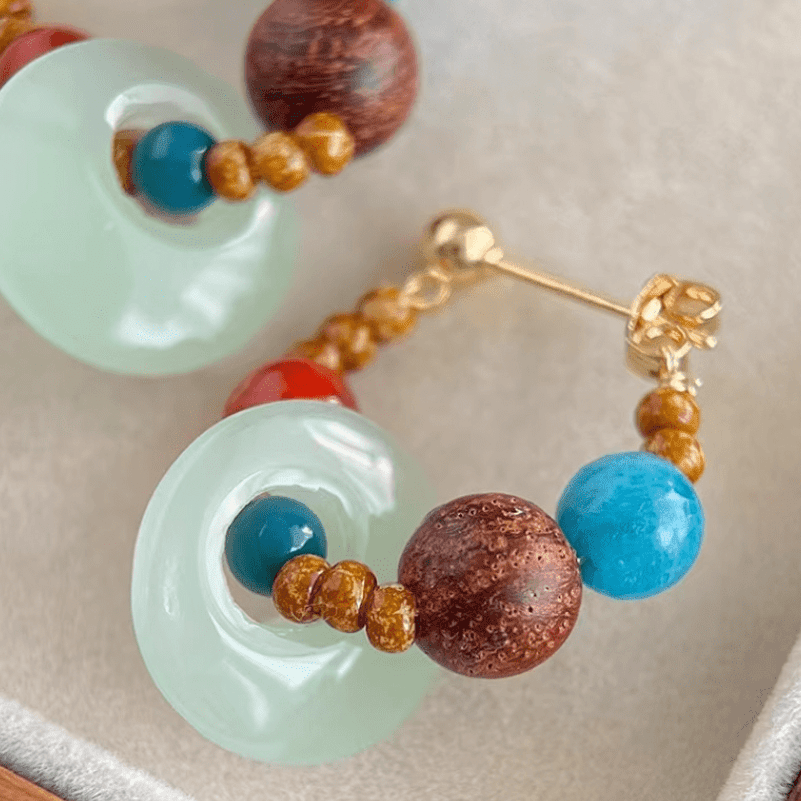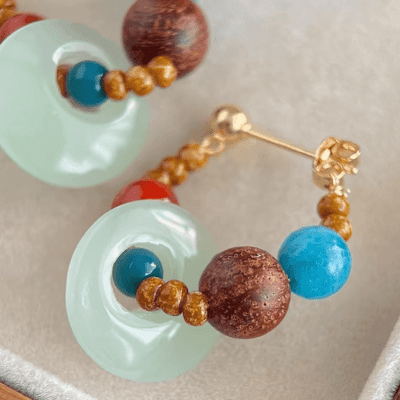Tibetan Crystal Earrings: Himalayan Mysticism, Zen Stillness, and Healing Grace in Every Glimmer

When the first ray of dawn slants across the Potala Palace’s golden roof, and the copper rings of prayer wheels hum with mantras in pilgrims’ palms, the highland wind whips prayer flags into a fervent dance—then, a faint coolness brushes the earlobe. These Tibetan crystal earrings are no ordinary trinkets. They are frost formed from Lasa’s moonlit nights, warmed by centuries of butter – lamp wicks; fragments of agate once used by Bon shamans to commune with mountain spirits, polished into Zen – like rounds by time; turquoise from temple altars, accidentally falling into a nomad’s satchel and journeying along prayer routes to become starlight at the ear. Every crystal carries the dust of circumambulation paths, the fragrance of butter tea, and the lingering echo of the Om Mani Padme Hum, trembling gently at the earlobe as if to whisper the Himalayas’ millennial mysticism to modern souls.
1. Ancient Roots: When Tibetan Spirits Met Crystal Whispers
Tibetan crystal earrings trace their lineage to the Tubo Dynasty, intertwined with the legend of Guru Rinpoche (Padmasambhava). In the 8th century, as the master journeyed to Tibet to propagate Buddhism, demons and spirits obstructed the construction of Samye Monastery. Guru Rinpoche, wielding turquoise as a divine sword and agate as a mantra – inscribed wheel, suppressed the seven demonic nodes. The crystals imbued with his dharma power later became the prototype of Tibetan earrings—within every turquoise bead lies the thunder of that demon – subduing act, and every agate holds the temple – guarding mantras.
Bon shamans, long before Buddhism, wore agate earrings to channel mountain spirits. The facets of these agates, catching firelight like caged stars, once witnessed shamans’ trances where they conversed with the spirits of Mount Kailash. In Tibetan Buddhism, earrings evolved into “ears of enlightenment.” A jade – disc earring (like the ping’an kou in images) symbolizes the Dharma Wheel, its circle embodying the cycles of samsara and liberation—echoing the Bardo Thodol’s teaching that “all phenomena are but the dance of emptiness.”

2. Meanings Woven in Crystal and Craft
Each earring is a tapestry of symbols, stitched with Himalayan wisdom, and often whispered in temple legends:
- Turquoise (Tears of Tara): Tibetans call turquoise “the tears of Green Tara.” Legend has it that when Green Tara saw beings tormented by karmic obstacles on the plateau, her compassionate tears fell, transforming into turquoise veins. Wearing a turquoise earring is like catching a teardrop of Tara’s mercy, calming the mind amid chaos—much like the morning mist in the Lasa Valley, gently embracing every restless heart.
- Carnelian (Fire of Sangha): Deep – red carnelian, often paired with silver in Tibetan designs, mirrors the color of monks’ robes catching the first sunlight. It is said that in the Gelugpa monastery, a monk once survived a bandit attack unharmed, wearing a carnelian earring blessed by his guru. Since then, carnelian has been revered as a symbol of steadfast faith, igniting inner courage.
- Jade Disc (Cycle of Wholeness): The circular jade ping’an kou represents the endless flow of samsara—birth, death, and rebirth. In the Sakya tradition, a high lama once gave a jade – disc earring to a dying disciple, saying, “This circle is the Buddha’s smile at impermanence.” Wearing it, one hears the whisper of Zen’s “beginner’s mind,” embracing all with equanimity.
- Enamel Phoenix (Divine Guardian): The vibrant phoenix in enamel earrings echoes the Tibetan khyung (mythical bird), guardian of the Dharma. Guru Rinpoche once summoned a khyung to vanquish a demon threatening Samye Monastery; its wings, spreading wisdom, chase away ignorance like a gust of pure wind.
3. Why Wear Tibetan Crystal Earrings?
Beyond adornment, they are portals to Tibetan mysticism and Zen clarity, their power rooted in centuries of spiritual lore:
- Healing Presence: Just as Guru Rinpoche used crystals to balance the elements, turquoise calms the mind (water element), carnelian stirs vitality (fire element)—each stone tunes into a different frequency, harmonizing body and spirit as Himalayan lamas do in meditation. A nomad once recounted: “After wearing a turquoise earring, my nightmares of yak herding disasters vanished.”
- Mystical Connection: Earrings with dzi – like patterns (or real dzi fragments) link you to ancient oracles. In Ngari, a herder found a dzi – patterned agate earring in a cave; soon after, his lost yak herd returned. It’s as if carrying a fragment of a Bon shaman’s amulet, whispering secrets of the plateau.
- Style with Soul: In modern fashion, these earrings blend Tibetan motifs with minimalist design—enamel phoenixes paired with sleek silver (echoing the union of wisdom and method), jade discs with wooden beads (recalling the interdependence of samsara and nirvana). They’re not just accessories but stories on the ear, like fragments of Terma (hidden teachings) revealed.
4. Choosing Your Tibetan Crystal Earring
Let the earrings choose you, guided by intuition and the whispers of Tibetan legends:
- For Calm: Turquoise – and – silver earrings, like the rustic – beaded design, ground you—as if holding a piece of Tibetan earth blessed by Padmasambhava’s footprints.
- For Courage: Carnelian – accented pieces, with their fiery glow, embolden you—perfect for new beginnings, like a nomad’s first step on a pilgrimage to Mount Kailash.
- For Wholeness: Jade – disc earrings, with their smooth circles, remind you of life’s cycles—wear them during transitions, as the Karmapa wears jade when crossing seasons.
- For Mystery: Enamel phoenix earrings, with their vivid hues, ignite curiosity—each feather a brushstroke of the khyung’s legend, guarding your path like Guru Rinpoche’s magic.
5. The Psychology of Wearing Sacred Adornments
Tibetan crystal earrings work on the mind as much as the spirit, their power amplified by centuries of devotional practice:
- Tactile Grounding: The cool touch of jade or the rough texture of silver beads anchors you in the present—like spinning a prayer wheel during anxiety, as the Fifth Dalai Lama did in times of turmoil.
- Visual Reminder: A glance at the phoenix or jade disc reconnects you to your intention—compassion, courage, or peace—turning routine into ritual, as monks turn mani stones into mantras.
- Cultural Reverence: Wearing these earrings honors Tibetan wisdom, fostering a sense of belonging to something timeless—like chanting mantras that transcend eras, as the Ganden Phodrang’s prayers have for 600 years.
6. Tibetan Earrings in Modern Fashion: A Bridge of Eras
Today’s designers fuse Tibetan heritage with contemporary elegance, weaving temple legends into every piece:
- Minimalist Zen: Jade discs paired with gold – filled chains, like the image’s delicate design, blend Tibetan wholeness with urban chic—perfect for office or meditation, as a modern yogi carries the Dharma in style.
- Bohemian Spirit: Turquoise – and – leather earrings, echoing nomadic jewelry, suit free spirits—each bead a story of the plateau’s winds, as a khampa warrior’s amulet once did.
- Statement Pieces: Enamel phoenix earrings, with their bold colors, make a cultural statement—wear them to honor Tibetan artistry at galas, as a jetsun (noble lady) once adorned herself with phoenix – themed jewels.
7. Caring for Your Tibetan Crystal Earrings
Treat them as sacred companions, and they’ll whisper temple secrets for years:
- Energetic Cleansing: Place them under Lasa – time moonlight (full moon preferred) to recharge, as Tibetan temples cleanse relics in the Gesar epic’s celestial light. Smudge with juniper smoke from Tsurphu Monastery for deeper purification.
- Physical Care: Wipe silver with a soft cloth to keep its luster; avoid soaking turquoise in water (it absorbs Tara’s tears, and moisture may dull their mercy). Store in a velvet pouch, away from harsh chemicals—like a terma chest hiding sacred texts.
- Restringing with Intention: If beads loosen, restring them mindfully—each knot a prayer, like a monk tying a khata for a long – lost disciple, weaving new intentions into the old dharma.
8. Conclusion: Earrings as Gateways
Tibetan crystal earrings are more than fashion—they’re living bridges between Himalayan mysticism, Zen stillness, and your soul. Whether the jade disc calms your mind (echoing Tara’s mercy), the phoenix ignites your spirit (as khyung guards the Dharma), or turquoise connects you to the sky (like Guru Rinpoche’s magic), each earring carries a fragment of the plateau’s wisdom.
Let them dangle as reminders: in the chaos of modern life, there’s a whisper of Tibetan mountains (where Padmasambhava meditated), a stillness of Zen gardens (echoing the Kanjur’s teachings), and a healing pulse of ancient crystals (holding Tara’s tears)—all within reach, at your ear.
FAQs
Q: Can non – Buddhists wear Tibetan crystal earrings?
A: Absolutely. Their power lies in respect and intention. Wear them as symbols of beauty, healing, or cultural appreciation—just as Tibetans greet all with an open heart, as the Four Immeasurables teach: boundless love, compassion, joy, and equanimity.
A: Absolutely. Their power lies in respect and intention. Wear them as symbols of beauty, healing, or cultural appreciation—just as Tibetans greet all with an open heart, as the Four Immeasurables teach: boundless love, compassion, joy, and equanimity.
Q: How to tell if a Tibetan – style earring is authentic?
A: Look for natural inclusions in crystals (turquoise’s web like Tara’s tear trails, carnelian’s hue variations as if kissed by monk’s robe light), and check the craftsmanship—authentic pieces have a “handmade energy,” like a nomad’s jewelry forged under the khyung’s watch.
A: Look for natural inclusions in crystals (turquoise’s web like Tara’s tear trails, carnelian’s hue variations as if kissed by monk’s robe light), and check the craftsmanship—authentic pieces have a “handmade energy,” like a nomad’s jewelry forged under the khyung’s watch.
Q: Do these earrings have specific spiritual meanings, or can I assign my own?
A: Both. Traditional meanings (Tara’s mercy, khyung’s protection) offer guidance, but your personal intention—courage, love, peace—infuses them with unique power, like a mantra you whisper to the stones, as a tulku (reincarnate lama) infuses amulets with new blessings.
A: Both. Traditional meanings (Tara’s mercy, khyung’s protection) offer guidance, but your personal intention—courage, love, peace—infuses them with unique power, like a mantra you whisper to the stones, as a tulku (reincarnate lama) infuses amulets with new blessings.
Q: What if an earring breaks?
A: Some see it as a release of old karma, as the Bardo teaches; practically, it’s a chance to restring with new intentions—like a phoenix rising from ashes, or a prayer wheel restarting its journey, carrying your renewed vows.
A: Some see it as a release of old karma, as the Bardo teaches; practically, it’s a chance to restring with new intentions—like a phoenix rising from ashes, or a prayer wheel restarting its journey, carrying your renewed vows.

